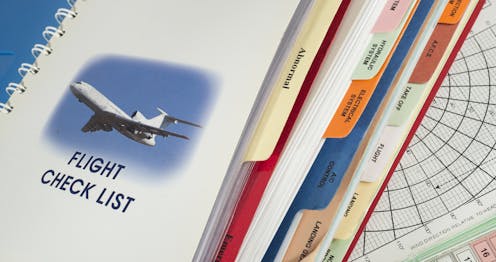the importance of pilot checklists
- Written by Geoffrey Dell, Associate Professor/Discipline Leader Accident Investigation and Forensics, CQUniversity Australia

One of the issues raised in the investigation of a Melbourne air crash that killed five people was the importance of pilots sticking to any pre-flight checklists.
Pilot Max Quartermain and four American tourists died when a Beechcraft B200 Super King Air VH-ZCR crashed into the DFO shopping centre shortly after takeoff from Essendon Airport on February 21, 2017.
The Australian Transport Safety Bureau (ATSB) report into the crash found the pilot did not detect that the aircraft’s rudder trim was not in the correct position before take-off. This rudder trim helps a pilot control an aircraft.
Read more: The black box: an Australian invention that nearly didn't happen
With the rudder trim incorrectly set, the report found, this adversely affected the aircraft’s take-off performance and ability to climb.
While not apportioning blame, the ATSB report said the rudder trim’s incorrect position was a contributing factor to the crash.
The ATSB’s chief commissioner Greg Hood said this accident emphasised the importance of having a cockpit checklist applicable to an aircraft’s specific and current modification status.
The report said it was not known whether the pilot had used a checklist on the day of the crash, but Mr Hood added:
In this particular tragic accident there were opportunities in the checklist that existed for the pilot to ensure the rudder trim was set to neutral prior to take-off.
Checklists for pilots
The use of checklists in single-pilot operations has been a contentious issue over the years. From the beginning of flight training, pilots are taught to memorise key checklists so they can readily recall and perform the required checks accurately.
In simpler cockpits, this process can provide reliable results. As the complexity of the aircraft systems and the cockpit controls increases, the inadequacy of solely relying on memory and recall becomes evident.
To minimise the likelihood of configuration errors in two-pilot airline operations, it is usual practice in each phase of flight for the cockpit to be initially configured by the pilots by recall.
The correct configuration is then checked by the two pilots by running through the applicable checklist.
The pilot not flying will usually call the item, both pilots will then check the appropriate switch or control setting. The pilot flying will verbally respond to the call to confirm the correct setting.
For a configuration error to occur in that environment, the setting has to be made incorrectly from recall, or omitted, in the first instance. Then both pilots have to miss the incorrect setting when the checklist call is made and responded to.
This method – sometimes referred to as a “challenge and response” method – provides two levels of procedural redundancy to guard against human errors that might otherwise lead to incorrect settings.
Single pilot operations
The challenge arises when considering how to achieve the same level of error-proofing in single-pilot operations. For example, a 2005 study for the NASA Ames Research Centre said:
… the failure to execute a checklist can cause readily detectable problems to remain undiscovered. Beyond simply being required, executing checklists is recognized by everyone as being essential to safe aircraft operation, and yet, checklist processing omissions and errors continue to be a factor in aircraft incidents and accidents.
New Zealand’s Civil Aviation Authority, in its advisory on single-pilot operations, said:
… the pilot is very reliant on the use of checklists to provide a suitable structure to replace the “Challenge and Response” checklists used in the multi-pilot cockpit.
Further, in discussion of single-pilot flying techniques, the US Aircraft Owners and Pilots Association said:
… proper checklist use is a skill with some overlooked subtleties. First, though, the pilot must be committed to, and recognize the need for, disciplined checklist use. Industry working groups have recognized that single-pilot adherence to checklist usage is an area with some room for improvement. Especially in new light jets with highly automated systems, pilots can develop complacency regarding checklist usage that grows with time and familiarity.
The drift into failure
Many years ago I delivered a paper at a safety conference in which I argued that deviation from approved procedures and practices erodes the safety margins that were afforded by the system. The magnitude and criticality of the reduction in protection was unknown until the margins had eroded to zero and an accident occurred.
More recently, safety expert Sidney Dekker described this phenomenon in his 2011 book Drift into Failure: From Hunting Broken Components to Understanding Complex Systems.
Read more: SharkSpotter combines AI and drone technology to spot sharks and aid swimmers on Australian beaches
One of the biggest problems with single-pilot operations is the fact that it is very difficult to self-diagnose errors and omissions, and to recognise the associated drift into failure.
Just telling people about error, as tends to be the case sometimes in industry, does not immunise them from making errors or omissions of their own.
The systems and procedural environment in which a person functions needs to help provide those checks and balances. In short, rigorous use of checklists by pilots in single-pilot operations is really the only protection available to prevent critical errors.
Authors: Geoffrey Dell, Associate Professor/Discipline Leader Accident Investigation and Forensics, CQUniversity Australia





